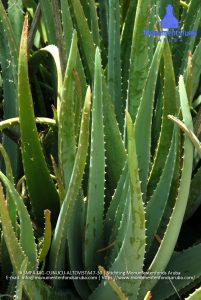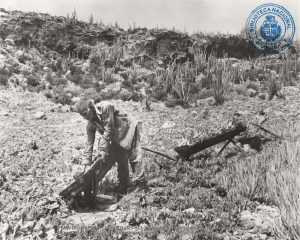ORANJESTAD – Aloe Vera, a succulent plant species, is renowned for its incredible properties for the skin. It is widely distributed and usually grows in tropical, semi-tropical and arid climates on the planet. But this plant also had a very prominent role in the history of Aruba, and its significance to the island’s economy endures to this day.
The leaves of Aloe Vera contain a good amount of gel which when used topically, is great for the skin. Traditionally, Arubans use this gel to treat minor burns and other skin ailments, or just to keep skin supple and looking bright and nourished. Aside from the gel, aloe contains a bitter, yellow substance (called aloin) which is a gentle but powerful laxative, and it is also the origin of the industry of aloe in Aruba.

Aloe vera was introduced in Aruba around 1840, when most of the island’s inhabitants were farmers of little means. Dutch Governor Van Raders introduced the plant after it had been introduced in other islands of the Caribbean to cultivate and harvest the aloe to produce the laxative.
Around 1920, about two-thirds of Aruba was aloe fields, earning our island the nickname “The Island of Aloes.”
Under Commander Jan Helenus Ferguson (1866-1871), aloe experienced a boom, which is why there is a road named after him, which goes through the aloe fields. In the 19th century, Aruba was the main supplier of aloin for laxative, which was imported abroad to the United States and Europe. The aloin from Aruba and Curaçao was known to be one of the best in the world and was more expensive, which meant that at the time, it had significant economic impact, particularly for the local farmers.

However, by the time the oil industry arrived on Aruba, it changed the labor market on Aruba, shifting away from agriculture. It would be after World War II that aloe would make a comeback. And eventually, as science learned about the amazing properties of aloe gel, the industry shifted from producing laxative to producing skin care. An interesting fact is that in 1951, the production of Aruban aloe amounted to around 30 percent of the total global production!

The impact and relevance of aloe is visible all around Aruba. While most homes will have a few plants for personal use and decoration, houses are also decorated with aloe motifs, and at some point, aloe even featured on post stamps. Around 1920, about two-thirds of Aruba was aloe fields, earning our island the nickname “The Island of Aloes.” And in 1955, the aloe became a part of Aruba’s coat of arms, symbolizing prosperity for the island.
Images from the archive of the National Library of Aruba.
















